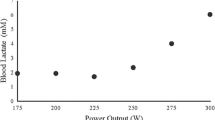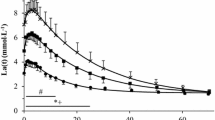Abstract
The lactic acid (L.A.) concentration in blood after a 20 sec supramaximal exercise (2.5×\(\dot V_{O_2 \max } \)) has been measured in 4 subjects in the following experimental conditions:
-
a)
during the resting period following the supramaximal exercise (rest recovery) and
-
b)
during a 3 min exercise at\(\dot V_{O_2 \max } \) immediately following the supramaximal effort (exercise recovery). The L.A. concentration in blood has been found to be consistently higher (on the average by 16.9 mg%) in case (b). Since in such condition it may be reasonably assumed that the oxygen taken up by the subject is completely utilized for the exercise, the increase of blood lactate is considered evidence for the occurrence of anaerobic recovery,i.e. of a partial resynthesis of the high energy phosphate stores of the muscle (GP = ATP+PC) depleted during the supramaximal effort, at the expense of anaerobic glycolysis.
From the increase in blood L.A. concentration during the anaerobic recovery period, the amount of L.A. produced has been estimated together with the amount of GP resynthesized. The latter corresponds to 4 to 7 mMoles/kg of muscle,i.e. to about 25% of the average GP concentration in resting human muscle. The finalistic implication of this mechanism is the prompt restoration of the potential maximal power of the muscle even in the absence of O2.
Similar content being viewed by others
References
Ambrosoli, G., Cerretelli, P.: The anaerobic recovery of frog muscle. Pflügers Arch.345, 131–143 (1973)
Cerretelli, P., di Prampero, P. E., Ambrosoli, G.: High energy phosphate resynthesis from anaerobic glycolysis in frog gastrocnemius muscle. Amer. J. Physiol.222, 1021–1026 (1972)
Cerretelli, P., Sikand, R., Farhi, L. E.: Readjustement in cardiac output and gas exchange during onset of exercise and recovery. J. appl. Physiol.21, 1345–1350 (1966)
Davies, C. T. M., Knibbs, A. V., Musgrove, J.: The effect of recovery exercise on the removal of lactic acid from blood. J. Physiol. (Lond.)196, 61–62P (1968)
Diamant, B., Karlsson, J., Saltin, B.: Muscle tissue lactate after maximal exercise in man. Acta physiol. scand.72, 383–384 (1968)
di Prampero, P. E.: The alactic oxygen debt: its power, capacity and efficiency. In: Muscle metabolism during exercise (B. Pernow, B. Saltin, Eds.), pp. 371–382. New York-London: Plenum Press 1971
di Prampero, P. E., Peeters, L., Margaria, R.: Alactic O2 debt and lactic acid production after supramaximal exercise in man. J. appl. Physiol.34, 628–632 (1973)
Embden, G., Hirsch-Kauffmann, H., Lehnartz, E., Deuticke, H. J.: Über den Verlauf der Milchsäurebildung beim Tetanus. Hoppe-Seylers Z. physiol. Chem.151, 209–231 (1926)
Embden, G., Lehnartz, E.: Über den zeitlichen Verlauf der Milchsäurebildung bei der Muskelkontraktion. Erwiderung auf die vorstehenden Bemerkungen von O. Meyerhof. Hoppe-Seylers Z. physiol. Chem.178, 311–315 (1928)
Embden, G., Lehnartz, E., Hentschel, H.: Der zeitliche Verlauf der Milchsäurebildung bei der Muskelkontraktion. Hoppe-Seylers Z. physiol. Chem.165, 255–278 (1927)
Gercken, G.: Die quantitative enzymatische Dehydrierung vonl(+)-Lactat für die Mikroanalyse. Hoppe-Seylers Z. physiol. Chem.320, 180–186 (1960)
Gisolfi, C., Robinson, S., Turrel, E. S.: Effects of aerobic work performed during recovery from exhaustive work. J. appl. Physiol.21, 1767–1772 (1966)
Hartree, W.: The analysis of the delayed heat production of muscle. J. Physiol. (Lond.)75, 273–287 (1932)
Hubbard, J. L.: The effect of exercise on lactate metabolism. J. Physiol. (Lond.)231, 1–18 (1973)
Margaria, R., Cerretelli, P., di Prampero, P. E., Massari, C., Torelli, G.: Kinetics and mechanism of oxygen debt contraction in man. J. appl. Physiol.18, 371–377 (1963)
Margaria, R., Cerretelli, P., Mangili, F.: Balance and kinetics of anaerobic energy release during strenuous exercise in man. J. appl. Physiol.19, 623–628 (1964)
Margaria, R., Moruzzi, G.: Il ristoro anaerobico del muscolo. Arch. Fisiol.37, 203–216 (1937)
Nachmansohn, D.: Über den Zerfall der Kreatinphosphorsäure in Zusammenhang mit der Tätigkeit des Muskels. I. Biochem. Z.196, 73–97 (1929)
Nachmansohn, D.: Über den Zerfall der Kreatinphosphorsäure in Zusammenhang mit der Tätigkeit des Muskels. II. Biochem. Z.208, 237–256 (1929)
Newman, E. V., Dill, D. B., Edwards, H. T., Webster, F. A.: The rate of lactic acid removal in exercise. Amer. J. Physiol.118, 457–462 (1937)
Sacks, J.: The absence of anaerobic recovery in mammalian muscle. Amer. J. Physiol.129, 761–764 (1939)
Taylor, H. L., Buskirk, E., Henschel, A.: Maximal oxygen intake as an objective measure of cardiorespiratory performance. J. appl. Physiol.8, 73–80 (1955)
Author information
Authors and Affiliations
Rights and permissions
About this article
Cite this article
Cerretelli, P., Ambrosoli, G. & Fumagalli, M. Anaerobic recovery in man. Europ. J. Appl. Physiol. 34, 141–148 (1975). https://doi.org/10.1007/BF00999926
Received:
Issue Date:
DOI: https://doi.org/10.1007/BF00999926




